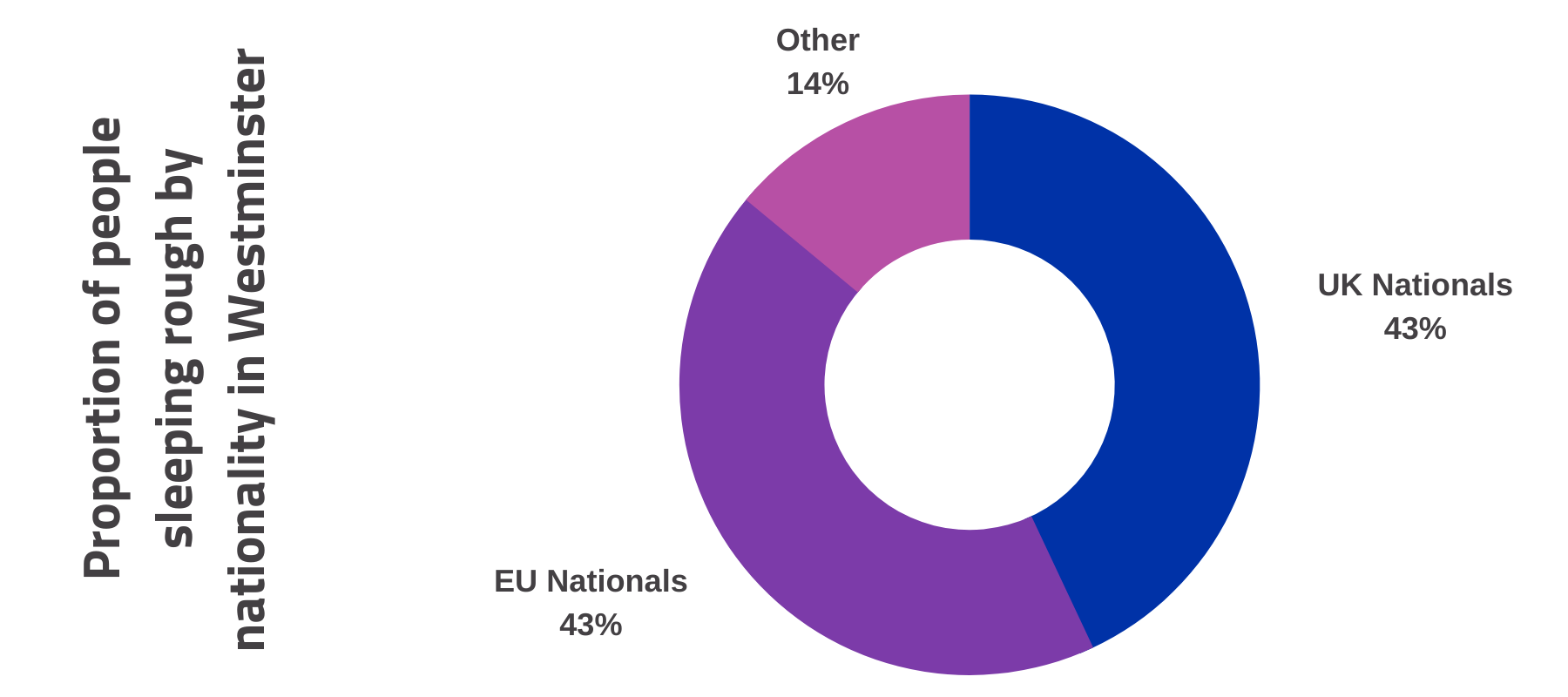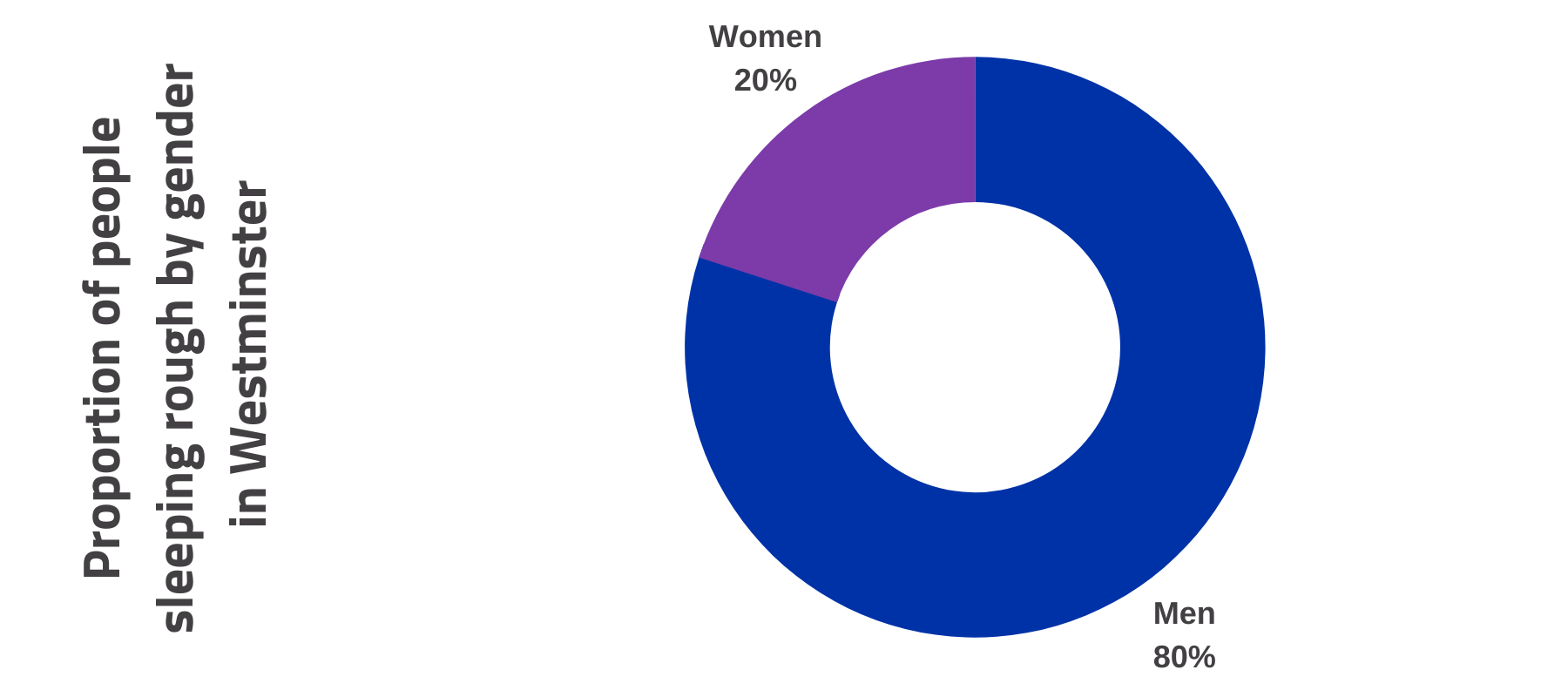Homelessness covers a range of experiences of when people lack a secure home – but how many people are facing homelessness?
All forms of homelessness stop people building a better life for themselves, and can cause long-term damage to physical and mental health. Let’s get into the specifics.
Someone sleeping rough doesn’t have a roof over their head at night and have to sleep on the streets or other open places. This is the most visible form of homelessness.
2998 people were estimated to be sleeping rough in England on any one night since March 2022.
This estimate is based on survey and street count data from local authorities.[1] There has been a sharp increase over the last six months, especially in Westminster which saw the largest increase of any London Borough.
Want to learn more about how we’re tackling this issue? Follow us on social media
The figure is an underestimate of the number of people out on a single night, because there will inevitably be some people missed by surveys.
Using other data, such as interactions with the health care and criminal justice systems, the charity Crisis has estimated that the true figure is about 8000 people.[2]
The total number of people experiencing rough sleeping at some point in the year is much greater, about seven or eight times as many in London,[3] as people move on and off the streets.

How Many People Are Homeless: nationality
Rough sleeping affects groups of people differently.
According to official statistics, in 2023, about 43% of people sleeping rough in Westminster were UK nationals, 43% were EU nationals and 14% came from other places globally. The rest were of unknown nationality.[4]

Source: Chain Report Q4 2023
Compared with the rest of England, the homeless population in London has a much higher proportion of non-UK nationals. Of these the largest proportion come from elsewhere in Europe, especially Central and Eastern Europe.
People from Central and Eastern Europe account for 32% of the London total, and probably more if those of unknown nationality are included.
Many non-UK European nationals sleeping rough have been in the UK for some time, but have now run into difficulties. Among non-UK European nationals using The Connection’s services over the last year, around half have been in the United Kingdom for more than five years.
Source: CHAIN Database
Gender:
People sleeping rough are mostly male. Survey data indicates that 19% of people sleeping rough in London are female.[5] However, in reality, the proportion of women may be higher than this as they tend to sleep in more hidden places for safety reasons, and so may not be seen by surveys.
That’s why we carried out our Women’s Census to get a better understanding of the experiences of women who sleep rough.

Source: Chain Report Q4 2023.
nb:No people of other gender identities were found sleeping rough. However, as LGBTQ+ persons are disproportionately represented in the rough sleeping population, this may be due fear over disclosing gender identity to researchers.
The total number of people facing homelessness is much greater than the number of people sleeping rough. About 74,230 Households need housing support from their local council.[6]
Many of these households contain more than one person, including children, so the total number of individuals is greater than this. The provided support, such as temporary accommodation, is often very poor quality.
A further 27,000 households were assessed as homeless but not entitled to temporary accommodation, for example because they were not considered to be in a vulnerable group.[7]
Those ineligible for support include those classified as “intentionally homeless”. This is a misleading term, as it suggests that people are pursuing a lifestyle choice, rather than feeling unable to ask for or undeserving of help. Many of this group end up sleeping rough due to lack of support.
The hidden homeless are people who don’t have somewhere suitable to live, but don’t qualify as legally homeless. For example, they may be living in grossly overcrowded housing, sheltering in disused housing, or finding temporary shelter with others.
There is no official data on how many hidden homeless there are. It is likely to be many tens of thousands,[8] but the true figure remains unknown and could be much higher.
What can you do?
Homelessness can seem to be a huge and unending issue, especially for those experiencing it.
But with your support, we are working towards moving people off the streets and ensuring homelessness, if unavoidable while address systematic concerns, is rare, brief and non-reoccurring.
Join The Connection Community to stay up-to-date on our work:
How Many People Are Homeless – References
[1] CHAIN Report Q1 2022
[2] https://www.crisis.org.uk/media/237582/crisis_homelessness_projections_2017.pdf
[3] Based on the number of people in the CHAIN database, compared with the street count data. The estimate applies to London as this is where data is available.
[4] Source: https://data.london.gov.uk/dataset/chain-reports
[5] Chain Report
[7] https://www.gov.uk/government/statistical-data-sets/live-tables-on-homelessness. Table 770.
[8] https://www.crisis.org.uk/media/237582/crisis_homelessness_projections_2017.pdf

